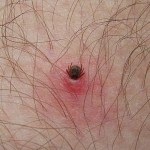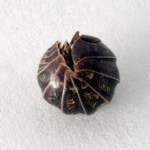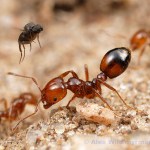parasite
Photo by: Leif Richardson, Dartmouth College
I came across this neat press release from the University of Massachusetts:
AMHERST, Mass. – Researchers studying the interaction between plants, pollinators and parasites report that in recent experiments, bees infected with a common intestinal parasite had reduced parasite levels in their guts after seven days if the bees also consumed natural toxins present in plant nectar.
In this early and most comprehensive study of its kind, researchers at the University of Massachusetts Amherst and Dartmouth College studied hundreds of eastern bumblebees…
(Orac note: I was away at Skepticon over the weekend, where I gave a talk entitled The Central Dogma of Alternative Medicine. (When the talk’s up on YouTube, I’ll provide a link, of course.) Because of all the fun and travel delays I didn’t get a chance to turn my slides and notes into a blog post yet. Also, I’m on vacation this week. However, this gives me the opportunity to resurrect a blog post from 2007, because I think the concept is interesting. I even use it in a slide that shows up in many of my talks (above). I’ve updated dead links and added some text to include relevant links to…
Image of a tick stealing a meal from: www2.outdoorchannel.com
Ticks are blood-sucking arthropods that can act as vectors for various diseases in both animals and humans. A recent article published in Frontiers in Zoology summarizes findings that suggest ticks may also be considered venomous ectoparasites. For example, Ixodes holocyclus is a species of Australian tick whose saliva can induce paralysis in humans and animals. According to the new article, about 8% of known tick species can induce paralysis. Ornithodoros savignyi ticks even secrete a lethal…
Image from www.Nematode.net.Credit: http://www.latech.edu/ans/faculty-staff/liberatos-james-d/parasite-pict…
Believe it or not, scientists at Albert Einstein College of Medicine in collaboration with Coronado Biosciences are intentionally infecting people who have autism with whipworms from pigs (Trichuris suis), although generally considered non-pathogenic to humans.
For some individuals, an elevated inflammatory state contributes to repetitive and irritable behaviors associated with autism. Researchers have observed that allergic responses (measured by skin prick tests) are higher in…
House sparrow in Mexico City. Photo Credit: © Víctor Argaez
Researchers Suárez-Rodríguez et al., observed house finches (C. mexicanus) and sparrows (P. domesticus) on the National University of Mexico campus in Mexico City routinely pulling apart cigarette butts to obtain the filters. The birds were found to incorporate the filters in their nests leaving researchers to speculate the purpose of used cigarette butts. Using heating elements to attract parasites, they found that probes covered in "used", i.e. artificially smoked, cigarette butts attracted fewer…
A study published in the European Journal of Personality suggests that humans infected with toxoplasmosis gondii are more extroverted compared to non-infected individuals. According to the CDC, roughly 22.5% of Americans over 12 are infected. The effects of the parasite are attributed to increased levels of dopamine in the brains of infected individuals. People can become infected with the parasite through exposure to undercooked contaminated meat, unwashed fruits and vegetables from contaminated soil as well as infected cat litter.
Source:
Lindová J, Příplatová L, Flegr J. Higher…
This is the fourth of 16 student posts, guest-authored by Eric Wika.
Let's face it, it's a dangerous world to be a brain. The brain is so soft and squishy it cannot even support its own weight. That's right, even gravity itself is enough to take out an unprotected brain. Besides these passive threats, there are several factions out there that active try to damage your brain! Zombies are an ever present menace which wish to eat our brains. TV will rot our brains, drugs will fry our brains and bullies will offer to “beat your brains in”. It's no wonder mother nature had to come up with the…
As part of a workshop on Creative Commons, I'm doing a short presentation on Open Data and The Panton Principles this week to various members of our staff. I thought I'd share some of the resources I've consulted during my preparations. I'm using textmining of journal articles as a example so I'm including a few resources along those lines as well.
The Panton Principles
Why does Dryad use CC0?
#sparc2012 a manifesto in absentia for Open Data
Information mining from Springer full-text: I ask for freedom
Textmining Update: Max Haussler's Questions to publishers: They have a duty to reply…
A normal giant gliding ant (left) and an infested ant (right). The red color of the gaster is not caused by a pigment, but thinning of the exoskeleton combined with the color of the nematode eggs. From Yanoviak et al, 2008.
In one of my favorite episodes of the animated TV show Futurama, the chief protagonist - delivery boy Philip J. Fry - becomes infested with worms after eating a dodgy egg-salad sandwich purchased from the restroom of an interstellar truck stop. Lucky for Fry, the parasites are beneficial - they repair his injuries and greatly enhance his cognitive abilities. ("Of all…
We here at Zooillogix balked at the idea of 'Zombie day' on ScienceBlogs (and secretly loved it, too). What better example than the animal world to show TRUE zombie-ism at its best?
Parasites.
Need I even say more? We've posted and posted again and posted another time about zombies before this day of celebration. But in honor of the day, we have found a few more interesting parasite zombie stories to share with your children when they are misbehaving.
Pillbugs. Potato bugs. Rolly pollies. Don't we all remember these little innocuous guys? But did you know they could be zombified?!…
So a week back or so, a number of friends read an article about death by rectal eel and immediately thought of me. For those of you who missed the story, it went a little something like this:
* Chinese man gets drunk with friends and passes out
* Friends think it would be hilarious to insert a large living swamp eel into the man's butt while he is unconscious
* Hilarity does not ensue. In fact, the man dies. Chinese doctor says the eel "consumed the man's bowels"
The article was widely reported in major news outlets like CNN and the Times, but I am linking instead to the UK edition of…
It's not every day that you hear about spy missions that involve a lack of sex, but clearly parasitic wasps don't pay much attention to Hollywood clichés.
These insects merge the thriller, science-fiction and horror genres, They lay their eggs inside other animals, turning them into slaves and living larders that are destined to be eaten inside-out by the developing grubs. To find their victims, they perform feats of espionage worthy of any secret agent, tapping into their mark's communication lines, tailing them back to their homes and infiltrating their families.
Two species of…
Millions of people in Latin America have been invade by a parasite - a trypanosome called Trypanosome cruzi. They are passed on through the bite of the blood-sucking assassin bug and they cause Chagas disease, a potentially fatal illness that affects the heart and digestive system. The infections are long-lasting; it can take decades for symptoms to show and a third of infected people eventually die from the disease. But T.cruzi does much more than invade our flesh and blood; it also infiltrates our genomes.
T.cruzi is unusual in that a massive proportion of its DNA, around 15-30%, lies…
tags: evolutionary biology, immunology, immune response, antibodies, parasite, avian pox virus, Poxvirus avium, nest fly, Philornis downsi, birds, ornithology, Darwin's Finches, Medium Ground Finch, Geospiza fortis, Ecuador, Galapagos Islands, researchblogging.org,peer-reviewed research, peer-reviewed paper
A male Medium Ground Finch, Geospiza fortis, sits on a tree branch in Ecuador's Galapagos Islands.
Image: Jen Koop.
People often view the Hawaiian islands as a tropical paradise, the ideal vacation site, but you wouldn't agree with this assessment if you happen to be a bird. According…
This is an updated version of the first post I wrote this year. The scientists in question were looking at ways of recruiting bacteria in the fight against mosquito-borne diseases, such as dengue fever. They've just published new results that expand on their earlier experiments.
Mosquitoes are incredibly successful parasites and cause millions of human deaths every year through the infections they spread. But they are no match for the most successful parasite of all - a bacterium called Wolbachia. It infects around 60% of the world's insect species and it could be our newest recruit in the…
At 13 metres in length, Tyrannosaurus rex had little to fear from other predators. But it was occasionally attacked by an enemy far smaller than itself. In a wonderful piece of forensic palaeontology, Ewan Wolff from the University of Wisconsin has shown that the tyrant lizard king was often infected by a microscopic parasite, whose relatives still infect the birds of today. Potentially transmitted through bites from other tyrannosaurs, the parasite could have starved the infected animals to death.
Many of the large meat-eating dinosaurs have wounds on their heads that were clearly inflicted…
Viruses and bacteria often act as parasites, infecting a host, reproducing at its expense and causing disease and death. But not always - sometimes, their infections are positively beneficial and on rare occasions, they can actually defend their hosts from parasitism rather than playing the role themselves.
In the body of one species of aphid, a bacterium and a virus have formed a unlikely partnership to defend their host from a lethal wasp called Aphidius ervi. The wasp turns aphids into living larders for its larvae, laying eggs inside unfortunate animals that are eventually eaten from…
Swine flu has made the world all too aware of the possibility of diseases making the leap from animal hosts to human ones. Now, we know that another disease made a similar transition from chimpanzees to humans, several thousand years ago. This particular infection is caused by a parasite, and a very familiar and dangerous one - Plasmodium falciparum, the agent responsible for malaria.
Transmitted by the bite of mosquitoes, P.falciparum infects over 500 million people every year. Its closest relative is a related parasite, Plasmodium reichenowi, which infects chimpanzees. Leading an…
In Lake Alexandrina, New Zealand, a population of snails is under threat from a parasitic flatworm, a fluke aptly known as Microphallus. The fluke chemically castrates its snail host and uses its body as a living incubator for its larvae. But the snails have a weapon against these body-snatching foes - sex.
The New Zealand mud snail Potamopyrgus antipodarum is found throughout island's freshwater habitats. They breed either sexually or asexually through cloning, and the two strategies vary in prevalence throughout the lake. In the shallower waters round its margins, sex is the name of the…
It seems like we've been covering zombie bugs a lot lately. The newest story comes from Texas, where researchers are trying out a new form of pest control on invasive fire ants: using parasitic flies to lay eggs in the ants brains, zombify them, and then explode their heads with emerging larvae. Seems reasonable.
We're under attack!
Researchers at Texas A&M's AgriLife Extension Service in Overton, in East Texas are experimenting by releasing four different species of phorid flies (a native predator of fire ants from their native South America) into fire ants' new habitats. The flies…




